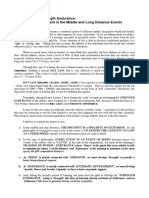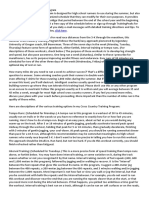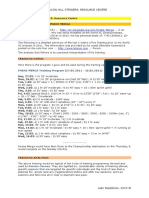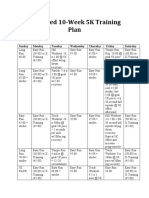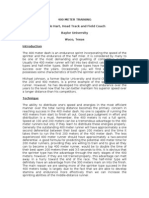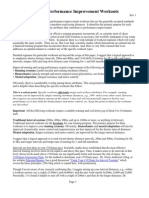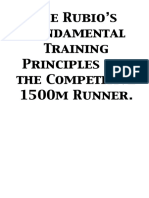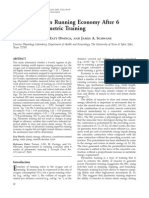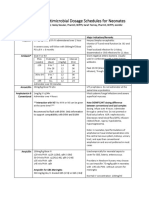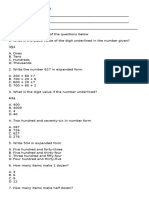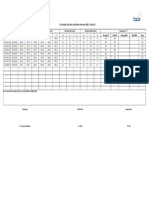100%(1)100% found this document useful (1 vote)
531 viewsSweat Elite: 5 Saptamani Antrenament
Sweat Elite: 5 Saptamani Antrenament
Uploaded by
Florin TirpeThe document summarizes the Lydiard training method, which consists of 4 sequential phases over 28 weeks culminating in a peak for a major race. Phase 1 is a 12-week base building period focused on aerobic capacity through long runs. Phase 2 is 4 weeks of hill training to develop strength. Phase 3 is 4 weeks of speed development. Phase 4 is a 4-week sharpening phase integrating speed and endurance through time trials. Tapering and rest occur the final 2 weeks before the target race.
Copyright:
© All Rights Reserved
Available Formats
Download as DOCX, PDF, TXT or read online from Scribd
Sweat Elite: 5 Saptamani Antrenament
Sweat Elite: 5 Saptamani Antrenament
Uploaded by
Florin Tirpe100%(1)100% found this document useful (1 vote)
531 views4 pagesThe document summarizes the Lydiard training method, which consists of 4 sequential phases over 28 weeks culminating in a peak for a major race. Phase 1 is a 12-week base building period focused on aerobic capacity through long runs. Phase 2 is 4 weeks of hill training to develop strength. Phase 3 is 4 weeks of speed development. Phase 4 is a 4-week sharpening phase integrating speed and endurance through time trials. Tapering and rest occur the final 2 weeks before the target race.
Original Description:
Fartlek
Original Title
Fart Lek
Copyright
© © All Rights Reserved
Available Formats
DOCX, PDF, TXT or read online from Scribd
Share this document
Did you find this document useful?
Is this content inappropriate?
The document summarizes the Lydiard training method, which consists of 4 sequential phases over 28 weeks culminating in a peak for a major race. Phase 1 is a 12-week base building period focused on aerobic capacity through long runs. Phase 2 is 4 weeks of hill training to develop strength. Phase 3 is 4 weeks of speed development. Phase 4 is a 4-week sharpening phase integrating speed and endurance through time trials. Tapering and rest occur the final 2 weeks before the target race.
Copyright:
© All Rights Reserved
Available Formats
Download as DOCX, PDF, TXT or read online from Scribd
Download as docx, pdf, or txt
100%(1)100% found this document useful (1 vote)
531 views4 pagesSweat Elite: 5 Saptamani Antrenament
Sweat Elite: 5 Saptamani Antrenament
Uploaded by
Florin TirpeThe document summarizes the Lydiard training method, which consists of 4 sequential phases over 28 weeks culminating in a peak for a major race. Phase 1 is a 12-week base building period focused on aerobic capacity through long runs. Phase 2 is 4 weeks of hill training to develop strength. Phase 3 is 4 weeks of speed development. Phase 4 is a 4-week sharpening phase integrating speed and endurance through time trials. Tapering and rest occur the final 2 weeks before the target race.
Copyright:
© All Rights Reserved
Available Formats
Download as DOCX, PDF, TXT or read online from Scribd
Download as docx, pdf, or txt
You are on page 1of 4
Sweat Elite
8 ore ·
There are 7 different fartlek workouts Eliud Kipchoge uses in his
training: https://goo.gl/UpZkij
- 10min reps with 2min rest. 4 x 10min is most common, sometimes they’ll do 5.
- 8mins reps with 2min rest. 6 x 8min is most common.
- 6min reps with 2min rest. 8 x 6min is most common.
- 4min reps with 2min rest. 10 x 4min is most common.
- 3min reps with 1min rest. 13 x 3min is most common, sometimes they’ll do 14-15.
- 2min reps with 1min rest. 17 x 2min is most common, sometimes they’ll do up to 20.
- 1min reps with 1min rest. 25 x 1min is most common, sometimes they’ll do up to 30.
5 saptamani antrenament
30 July – AM 10 miles / 16km (60:18) | PM 5 miles / 8km (32:45)
31 July – 20min warm up (3miles / 4.6km), Drills, 4 miles tempo in 19:23 (5min
rest), 5x150m in 18.8 average (walk back rest), 20min cool down 2.5 miles
(4km)
1 Aug – Rest (light massage)
2 Aug – AM 8 miles / 12.8km (47:43) | PM 5 miles / 8km (32:54)
3 Aug – AM 6 miles / 9.65km (36:10) + 4 x 100m strides
4 Aug – 10000m Final: 1st 27:30
8 Aug – 5000m Heat: 3rd 13:26
11 Aug – 5000m Final: 1st 13:41
Sondre Moen - Track session 3 weeks before Marathon PB 2:05:48
Track:
2 x 3000m (recovery 3’) in 9:00, 8:55
3 x 2000m (rec. 3’) in 5:54, 5:55, 5:53
5 x 1000m (rec. 2’) in 2:57, 2:57, 2:57, 2:56, 2:59
6 x 500m (rec. 1’30”) in 1:27, 1:27, 1:28, 1:27, 1:27, 1:25
Fundamentals of the Lydiard
Method (Part 1 of 5)
[Article by Chelsea Ho of Sweat Elite]
This is the beginning of a five-part series with subsequent
articles diving deeper into the specifics and physiological
basis of each phase.
Almost 60 years ago, New Zealand coach Arthur Lydiard
pioneered a breakthrough in the distance running world. His
athletes included Peter Snell, Murray Halberg and Barry
Magee, who dominated the global running stage especially
at the Rome 1960 Olympic Games. Since then, his principles
stood the test of time and form the basis of most elite and
recreational training programs today.
The emphasis is on building a substantial mileage base and
limiting the frequency and duration of anaerobic sessions,
relative to other strategies at the time. Runners must listen
to their body and adjust their effort levels to prevent over
or undertraining at any one time (aka ‘Response Regulated
Training’ and ‘Feeling Based Training’).
Phases
A fundamental of the regimen is the dividing of the training
period into sequential phases. The ideal schedule spans
across 28 weeks and culminates in a peak cardiovascular,
muscular and mental condition for one major race. Each
phase is progressively shorter than the previous, with the
final weeks acting as a fine-tuner for enhanced
performance.
Phase 1: Base Training
This is a 12-week period of building a strong aerobic
capacity (aka stamina) and is considered the most
important phase. In general, each week includes 3 long
runs (1x2hrs, 2x1hrs) at an intensity that should make you
“pleasantly tired”. The other days include 1x0.5hrs run and
shorter, easier runs (aka recovery runs). The key is focusing
on the total time of each run.
To find your pace for the longer runs, you should be able to
run 15 minutes and comfortably return in a slightly faster
time. If you are unable to achieve a slight negative split,
then you will need to slow your pace. If you’re starting to
feel the accumulation of lactate, you will need to slow
down.
Lydiard recommends alternating courses between flat,
undulating and hilly in order to increase capillarization and
aerobic capacity.
Phase 2: Hill Training
The next 4 weeks incorporate hill training to develop leg
strength and flexibility, while maintaining and increasing
aerobic fitness. Find a hill with three parts: a 200-400m flat
section, a 200-300m long rise of about 5-15 degrees, and a
flat or slightly downhill section at the top for recovery.
Three days a week, warm up and then bound uphill with a
“springing” action. At the top, jog easily for three minutes
and then jog downhill to the base to repeat the uphill
bounding. Every three or four uphill repetitions, include a
few 50-400m sprints on the flat ground at the base – this
marks the end of a complete circuit. Repeat the circuits,
aiming for 1hr total workout time (including warm-up and
cool-down).
On another day, include a steady 2 or 1 ½ hour run. On the
three remaining days focus on speed: 10 repetitions of 120-
150 metres on a flat or downhill surface.
Phase 3: Speed Development
This 4-week phase involves three days of fast running
totalling about three miles. For remaining days, incorporate
the sessions characteristic of previous phases to maintain
aerobic fitness and functional leg strength. More details to
come in a subsequent article.
Phase 4: Sharpening
The 4-week phase integrates speed and stamina into a
race-specific fine-tuning. Each week involves three
fundamental workouts: 1) the long run, 2) anaerobic
workout, e.g. 2000m of 50m sprinting/50m float and 3)
time-trial for half to full race distance. Ideally do time trials
on a 400m track and record each lap time. On remaining
days, include sprint training, pace judgement, leg-speed
workouts, etc.
Tapering and Rest
For the final two weeks, continue to train daily but limit
faster running in amount and maintain a lighter effort in
longer runs. The goal should be to build mental and
physical reserve for the race.
You might also like
- Schwartz - Critical Velocity TrainingDocument4 pagesSchwartz - Critical Velocity TrainingJay MikeNo ratings yet
- IBT Practice Test Grade 4 Maths PDFDocument6 pagesIBT Practice Test Grade 4 Maths PDFAlyssa L50% (2)
- 800m Training PlansDocument6 pages800m Training PlansWalcyr GuilhermeNo ratings yet
- Veronique BillatDocument30 pagesVeronique BillatAltec Alsing100% (2)
- Book of Programmes for the Team Sport Athlete; Size & StrengthFrom EverandBook of Programmes for the Team Sport Athlete; Size & StrengthNo ratings yet
- 3k Workouts and How To Progress ThemDocument3 pages3k Workouts and How To Progress ThemmoggilavannanNo ratings yet
- Renato Canova Development of Strengthy EnduranceDocument12 pagesRenato Canova Development of Strengthy EnduranceDarwins Mendoza100% (1)
- Renato Canova 800 M PostDocument33 pagesRenato Canova 800 M Postcleanpillar100% (1)
- 10k Workouts and How To Progress ThemDocument4 pages10k Workouts and How To Progress ThemAna Duran100% (1)
- FIRST To The Finish 5K Training ProgramDocument2 pagesFIRST To The Finish 5K Training ProgramJuanlee09No ratings yet
- Circuit Breakers PresentationDocument49 pagesCircuit Breakers PresentationSyed Muhammad Munavvar Hussain89% (19)
- Speedwork: Speed Sessions That Will Guarantee Faster RunningDocument5 pagesSpeedwork: Speed Sessions That Will Guarantee Faster Runningbradders60No ratings yet
- Click Here: Cross Country - Summer Training ProgramDocument4 pagesClick Here: Cross Country - Summer Training ProgramHairfa Che Zair100% (1)
- Szewinska A Years Training Program For Women Sprinters PDFDocument5 pagesSzewinska A Years Training Program For Women Sprinters PDFZachary Lee100% (1)
- 800 Meters Steve GardinerDocument7 pages800 Meters Steve GardinerFagaras MoniNo ratings yet
- Training Analysis Imane MergaDocument2 pagesTraining Analysis Imane MergaJankmael99No ratings yet
- There's Speed Work, and Then There's Speed Work.: Speed Development How and Why To Improve Your Real SpeedDocument4 pagesThere's Speed Work, and Then There's Speed Work.: Speed Development How and Why To Improve Your Real SpeedTudor Necula100% (1)
- 1600m3200mtraining TomSchwartz AllRightsReserved PDFDocument14 pages1600m3200mtraining TomSchwartz AllRightsReserved PDFaman dhillonNo ratings yet
- Athletics Project Science of Living ProjectDocument9 pagesAthletics Project Science of Living ProjectAnonymous 8HVq0DNo ratings yet
- 5K Advanced Training Plan1 PDFDocument3 pages5K Advanced Training Plan1 PDFxiaokiaNo ratings yet
- Clinic Notes Arbogast2 PDFDocument6 pagesClinic Notes Arbogast2 PDFSanjeev KumarNo ratings yet
- FIRST Training PacesDocument10 pagesFIRST Training PacesAndi YoshNo ratings yet
- Peter Thompson-Design More Effective Sessions With New Interval TrainingDocument10 pagesPeter Thompson-Design More Effective Sessions With New Interval TrainingChris NickinsonNo ratings yet
- Cross Country - Summer Training Program: Click HereDocument14 pagesCross Country - Summer Training Program: Click HereJ Elias StokesNo ratings yet
- Something New in TrainingDocument9 pagesSomething New in Trainingr3linkedin100% (4)
- Increase Your VO2maxDocument8 pagesIncrease Your VO2maxAnonymous u0Hw9gGMoaNo ratings yet
- R Canova 800 Metri (4 PG)Document4 pagesR Canova 800 Metri (4 PG)Demetrio FrattarelliNo ratings yet
- Winter TrainingDocument4 pagesWinter TrainingJean Louis AbenaNo ratings yet
- Durham Desmond Symposium2015 PDFDocument33 pagesDurham Desmond Symposium2015 PDFcrisanto ValdezNo ratings yet
- Periodization Worksheet 1Document4 pagesPeriodization Worksheet 1api-264471866No ratings yet
- 400 MDocument13 pages400 MWu Zheng Feng60% (5)
- Macro Cycle 2Document9 pagesMacro Cycle 2mehrdad_44No ratings yet
- 10 Golden Running Rules of World Famous Coach - Alberto SalazarDocument6 pages10 Golden Running Rules of World Famous Coach - Alberto SalazarDemetrio FrattarelliNo ratings yet
- Periodization WorksheetDocument4 pagesPeriodization Worksheetapi-273149310No ratings yet
- Sprint Training For Distance RunnersDocument5 pagesSprint Training For Distance Runnersmelmel81100% (2)
- 1500 Meters Annual PlanDocument32 pages1500 Meters Annual PlanOscar CommentzNo ratings yet
- 5K Training WorkoutsDocument2 pages5K Training WorkoutsAmanda McNabb100% (1)
- Training The 800m RunnerDocument6 pagesTraining The 800m RunnerrmoganadassNo ratings yet
- 105-Peter Warden Plano Treino BarreirasDocument4 pages105-Peter Warden Plano Treino BarreirasJoão de AlmeidaNo ratings yet
- Advanced 5K Training Program!: Start Date: Monday, March 8Document1 pageAdvanced 5K Training Program!: Start Date: Monday, March 8Shahid HanifNo ratings yet
- High Intensity Interval Training HIIT Program PDFDocument2 pagesHigh Intensity Interval Training HIIT Program PDFNikolaNo ratings yet
- McFarlane Womens 100mHDocument5 pagesMcFarlane Womens 100mHZachary LeeNo ratings yet
- Intervals, Thresholds, and Long Slow Distance - The Role of Intensity and Duration in Endurance TrainingDocument26 pagesIntervals, Thresholds, and Long Slow Distance - The Role of Intensity and Duration in Endurance TrainingAlexandru SeciuNo ratings yet
- Jack Daniels - Threshold TrainingDocument6 pagesJack Daniels - Threshold TrainingMondlTNo ratings yet
- Cross Country LetterDocument2 pagesCross Country Letterapi-113553268No ratings yet
- ExplosiveIntervals, BillatDocument4 pagesExplosiveIntervals, Billatdf2medNo ratings yet
- Middle Distance GuideDocument74 pagesMiddle Distance GuideJOSEF NEBLETT100% (1)
- Basic Level 1500 Meter and Mile Training Program PDFDocument4 pagesBasic Level 1500 Meter and Mile Training Program PDFKris Cunningham50% (2)
- 100 110m Hurdle Training Sprint-Lindeman-Symposium-2015Document29 pages100 110m Hurdle Training Sprint-Lindeman-Symposium-2015Raul Terry Lauto100% (1)
- 400 para JovenesDocument20 pages400 para JovenesRodrigo Cuello RomeroNo ratings yet
- HurdleDocument7 pagesHurdlemanrunnerNo ratings yet
- Critical Velocity PPTDocument20 pagesCritical Velocity PPTAbdyljepbar HamedowNo ratings yet
- Phase Weeks DescriptionDocument3 pagesPhase Weeks DescriptionJinsen Paul MartinNo ratings yet
- African Runners Dominance in Distance RunningDocument57 pagesAfrican Runners Dominance in Distance Runninglazarus81No ratings yet
- 800 Training 2015Document1 page800 Training 2015Cássio Endo100% (4)
- 4x100 Relay StrategiesDocument13 pages4x100 Relay Strategiesapi-313469173No ratings yet
- Plyometric Training and Distance RunningDocument8 pagesPlyometric Training and Distance RunningDan FongNo ratings yet
- 800m TrainingDocument33 pages800m TrainingMinisterio Shabbat100% (1)
- Junior 400m SprintDocument8 pagesJunior 400m SprintLeehirzan LeehirzanNo ratings yet
- Summer Training For Speed: Alwyn Cosgrove's Training Design ProgramDocument6 pagesSummer Training For Speed: Alwyn Cosgrove's Training Design ProgramSteve HeywoodNo ratings yet
- CS WCMC Assignment II AnsDocument8 pagesCS WCMC Assignment II AnsyeabmelkamuNo ratings yet
- Supported SFPs LatestDocument28 pagesSupported SFPs LatestvicNo ratings yet
- FINAL SIP Activated CarbonDocument9 pagesFINAL SIP Activated CarbonJames KryptonNo ratings yet
- Breakaway Expeditionary Force Book 12 by Craig AlansonDocument510 pagesBreakaway Expeditionary Force Book 12 by Craig Alansonadd2013100% (2)
- Renault Clio III Cup Eng 100Document5 pagesRenault Clio III Cup Eng 100Jose López NodaNo ratings yet
- MorookaDocument2 pagesMorookaYudi setiawanNo ratings yet
- Roxas National High School: Republic of The Philippines Department of Education Region 02 (Cagayan Valley)Document30 pagesRoxas National High School: Republic of The Philippines Department of Education Region 02 (Cagayan Valley)Rein Paul Pascua TomasNo ratings yet
- NICU ABX ChartDocument11 pagesNICU ABX Chartdrchi100% (1)
- Repeat BreederDocument144 pagesRepeat Breederdrjyotivet100% (1)
- Catalog AC Single Split Package (BIG RAC) PDFDocument12 pagesCatalog AC Single Split Package (BIG RAC) PDFDevinta wardhaniNo ratings yet
- SAGE Profile V6.3.2 User Manual - Volume 4Document35 pagesSAGE Profile V6.3.2 User Manual - Volume 4GodwinNo ratings yet
- CR420Document56 pagesCR420Gikcoklat AmuntaiNo ratings yet
- Method StatementDocument5 pagesMethod Statementnayum100% (1)
- Guidelines To R3337 Food Labeling Regulations Draft 1685509864Document109 pagesGuidelines To R3337 Food Labeling Regulations Draft 1685509864Cosmic Moon BabyNo ratings yet
- Mathematics RevisionDocument10 pagesMathematics RevisionKadeen BeckfordNo ratings yet
- Worksheet - Left and RightDocument1 pageWorksheet - Left and RightingridvbaurelioNo ratings yet
- Sathish Full ThesisDocument62 pagesSathish Full ThesisSathis KumarNo ratings yet
- Gaylene Duncan Var11 Portfolio Presentation 1 Part 2Document55 pagesGaylene Duncan Var11 Portfolio Presentation 1 Part 2api-263552210No ratings yet
- Pharmaceutical-Chemistry PDFDocument1 pagePharmaceutical-Chemistry PDFDhruba Jyoti Baruah0% (1)
- Equal and Reducing Tees: MSS SP-75 ANSI B16.9 (In MM) Wellgrow's StandardDocument4 pagesEqual and Reducing Tees: MSS SP-75 ANSI B16.9 (In MM) Wellgrow's Standardtez tezNo ratings yet
- Retaining Walls Damaged in The Chi-Chi EARTHQUAKEDocument13 pagesRetaining Walls Damaged in The Chi-Chi EARTHQUAKEDaniel PatiñoNo ratings yet
- HDPE الوسايلDocument151 pagesHDPE الوسايلMohamed ElarabiNo ratings yet
- Solo Run Test Load Motor Hammer Mill - Crusher BDocument1 pageSolo Run Test Load Motor Hammer Mill - Crusher BEngineering PLTU BanjarsariNo ratings yet
- A Muslim Declaration of Human Rights - Article - RenovatioDocument11 pagesA Muslim Declaration of Human Rights - Article - RenovatioYusuf MuhammadNo ratings yet
- Finar Limited - Laboratory Chemicals - Price List 2020-2021Document148 pagesFinar Limited - Laboratory Chemicals - Price List 2020-2021finar chemicalsNo ratings yet
- Millat TractorsDocument16 pagesMillat TractorsNoman AmjadNo ratings yet
- To Apply Test Pressure: Between SealsDocument1 pageTo Apply Test Pressure: Between SealsAnthony Lakpah100% (1)
- JPT July PDFDocument132 pagesJPT July PDFAdri Coca SuaznabarNo ratings yet







